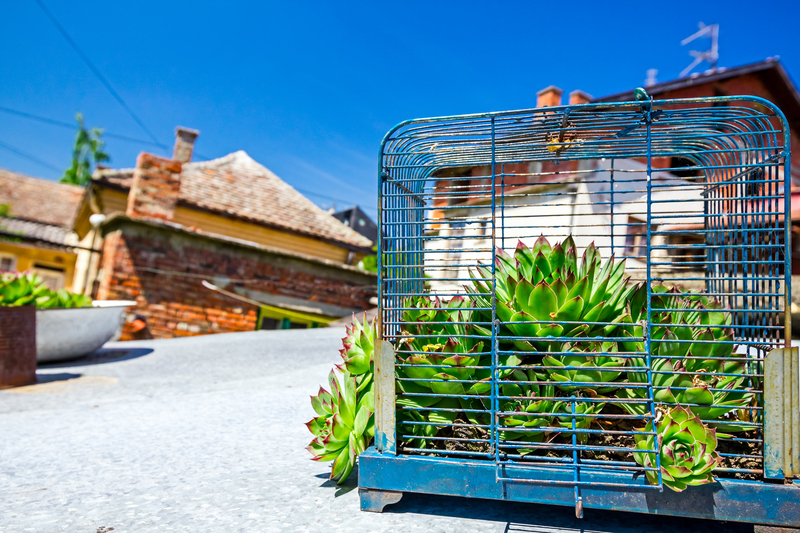Nutrient Recycling through Organic Waste
Posted on 04/09/2025
Nutrient Recycling through Organic Waste: A Comprehensive Guide
The world is facing significant challenges surrounding sustainability, soil fertility, and environmental health. Nutrient recycling through organic waste is emerging as a vital strategy to resolve these concerns, helping close the loop in food systems, reduce landfill pressure, and bolster agricultural productivity. In this guide, we'll dive deep into what nutrient recycling entails, its benefits, different methods, challenges, and how individuals and communities can effectively implement organic waste recycling systems.
Understanding Nutrient Recycling and Organic Waste
Nutrient recycling refers to the process of reusing the essential elements (such as nitrogen, phosphorus, and potassium) present in organic materials instead of letting them go to waste. Organic waste includes food scraps, yard trimmings, agricultural residues, and other degradable materials derived from plants and animals.
When these materials decompose naturally or through engineered processes like composting, they release valuable nutrients back into the soil. This process mimics natural ecosystems, where organic matter continually breaks down and nourishes future generations of plants.
Why is Nutrient Cycling Important?
- Reduces Dependency on Synthetic Fertilizers: Organic nutrient recycling supplies farms and gardens with natural fertilizers, lowering the demand for costly and often environmentally damaging synthetic alternatives.
- Combats Soil Degradation: Regular application of compost and organic amendments improves soil structure, fertility, and biodiversity.
- Minimizes Waste: Diverting organic waste from landfills reduces greenhouse gas emissions (like methane) and offers an environmentally friendly waste management solution.
- Supports Sustainable Agriculture: Closed-loop nutrient cycles reduce environmental impact and encourage more sustainable food production systems.

Main Steps in Nutrient Recycling through Organic Waste
Understanding the steps in nutrient recycling can help ensure an effective and eco-friendly process. Below, we explore the pathway organic waste takes from source to resource.
1. Collection of Organic Waste
- Food wastes from households, canteens, and markets
- Yard trimmings and garden waste
- Agricultural residues and manure from farms
Proper segregation at the source is crucial to prevent contamination and ensure high-quality compost or digestate.
2. Processing Methods
There are several efficient ways to process organic waste for nutrient recovery:
- Composting: Decomposition of organic materials by microbes under controlled aerobic conditions. Produces nutrient-rich compost.
- Vermicomposting: Utilizes earthworms to accelerate the breakdown, resulting in high-quality vermicastings.
- Anaerobic Digestion: Microbial decomposition in the absence of oxygen, producing biogas (renewable energy) and digestate that serves as fertilizer.
- Bokashi Fermentation: A fast, low-odor method relying on beneficial microbes. Produces pre-compost that can enrich soil after a short burial period.
3. Application to Soil
Once processed, the resulting product (compost, vermicast, or digestate) is applied to farms, gardens, or landscaping projects. These organic amendments supply crucial nutrients, promote soil health, and foster sustainable food production.
Benefits of Recycling Nutrients from Organic Waste
Recycling nutrients through organic waste is a cornerstone of sustainable agriculture and environmental protection. Let's explore the major advantages:
- Enhanced Soil Fertility: Compost supplies a balanced mix of macro and micronutrients, boosting plant health and growth.
- Water Retention: Enriched soil holds more water, reducing irrigation needs and improving drought resilience.
- Reduced Soil Erosion: Improved soil structure anchors roots and limits runoff, preserving valuable topsoil for future use.
- Mitigated Pollution: Recycling organic nutrients lessens nutrient runoff that can cause eutrophication in rivers and lakes.
- Lower Greenhouse Gas Emissions: Diverting food and green waste from landfills curtails methane emissions, a potent greenhouse gas.
- Economic Savings: Local nutrient cycling slashes fertilizer costs for farmers and reduces municipal waste management expenses.
Exploring Different Types of Organic Waste Suitable for Nutrient Recycling
- Food scraps: Vegetable peels, fruit rinds, coffee grounds, eggshells, and plate leftovers.
- Yard waste: Grass clippings, fallen leaves, pruned branches, weeds.
- Agricultural byproducts: Crop residues, straw, husks, animal manure.
- Processing waste: Brewery grains, spent mushroom substrate, vegetable canning waste.
Note: Not all organic materials are suitable for home composting. Avoid diseased plants, oils, meats, and heavily processed food to avoid odors and pests.
Methods of Nutrient Recycling: How Does It Work?
Composting
Composting is the most accessible way to recycle nutrients. It replicates natural decomposition under optimal conditions, with the right balance of carbon-rich (browns) and nitrogen-rich (greens) materials, oxygen, and moisture.
- Hot composting: Faster process requiring regular turning for aeration and heat buildup to destroy pathogens and weed seeds.
- Cold composting: Less labor-intensive, slower pile with less frequent turning; suitable for backyard composters with patience.
- Windrow and aerated static piles: Large-scale systems for communities and municipalities.
Anaerobic Digestion
Anaerobic digestion involves sealed reactors where microbes break down organic matter in the absence of oxygen, producing biogas (mainly methane and CO2) and a stabilized fertilizer residue (digestate). This method is common in large-scale farms and waste management operations.
Vermicomposting
Vermicomposting employs specific worms (like Eisenia fetida) to digest food scraps and bedding material. The result is worm castings, an incredibly nutrient-rich soil amendment prized by gardeners.
Black Soldier Fly Larvae Composting
This innovative method uses larvae to rapidly consume food waste. The resulting frass (larval waste) is nutrient-dense and can be used as a fertilizer. The harvested larvae themselves may become animal feed, further closing resource loops.
Challenges in Organic Waste Nutrient Cycling
- Contamination: Plastics, chemicals, and non-compostable items in waste streams can reduce nutrient recovery quality.
- Lack of Awareness: Many households and businesses are unfamiliar with best practices for organic waste segregation and utilization.
- Infrastructure Gaps: Not all communities have access to composting or biogas facilities.
- Policy Limitations: Inconsistent regulations and incentives can hamper widescale adoption of nutrient recycling initiatives.
- Transportation Costs: Collecting and moving organic waste, especially in rural or sprawling urban areas, may offset some environmental gains.
Best Practices for Maximizing Nutrient Recycling from Organic Waste
- Source Separation: Teach and enforce proper sorting of organic from inorganic waste at the earliest stage.
- Composting Technique: Optimize ratios of "greens" and "browns" (carbon and nitrogen sources), maintain moisture and aeration, and shred materials for faster breakdown.
- Local Solutions: Promote composting at home, in community gardens, or at neighborhood drop-off points to minimize transport emissions and close nutrient loops regionally.
- Utilize End Products: Regularly apply compost, worm castings, or digestate to farms, landscapes, or gardens for immediate benefit.
- Education and Policy: Advocate for supportive policy, educational campaigns, and incentives targeting both businesses and households.
Case Studies: Successful Implementation of Organic Waste Nutrient Recycling
Urban Composting Initiatives
Major cities like San Francisco, Stockholm, and Toronto have adopted mandatory organic waste separation and citywide composting programs. These systems divert thousands of tons of food scraps and yard waste from landfills annually, producing compost for city parks, farms, and landscaping projects.
Farm-Scale Biogas Facilities
In rural communities in India, Kenya, and Germany, smallholder farmers and cooperatives use anaerobic digesters to convert cattle manure and crop residues into biogas for cooking and digestate for fertilizing fields, improving soil health and cutting firewood needs.
Educational Composting in Schools
Many schools integrate composting into their science and environmental education curricula. Cafeteria waste is composted on-site, and the finished product is used in school gardens, reinforcing lessons about ecology, food systems, and sustainability.
Potential of Nutrient Recycling in a Circular Economy
The concept of the circular economy revolves around keeping resources in use for as long as possible, extracting maximum value before returning nutrients to the biosphere. Nutrient recycling from organic waste is a keystone for circularity in agriculture and food systems.
- Transforms "waste" into valuable soil inputs and renewable energy
- Reduces the need for imported synthetic fertilizers and fossil fuels
- Supports local jobs and promotes resilient local economies
By prioritizing nutrient cycling, societies can drastically reduce resource extraction, limit landfill expansion, and foster an agriculture that regenerates the environment rather than depleting it.
How Individuals and Communities Can Start Recycling Nutrients from Organic Waste
At the Household Level
- Set up a home compost bin system (outdoor piles, tumblers, or indoor worm bins)
- Separate food scraps and yard waste from trash
- Educate family members about what is compostable
- Use compost in gardens or donate to local green spaces
In Community Spaces
- Create neighborhood or community garden composting sites
- Volunteer for or organize food waste collection programs
- Partner with local farms or urban agriculture projects for nutrient cycling collaborations
- Advocate for municipal organic waste collection and composting facilities
For Businesses and Institutions
- Conduct waste audits and implement organic waste diversion programs
- Work with composting or biogas companies for processing services
- Utilize finished compost on landscaping, lawns, or donate to local growers
- Offer incentives for employees and customers to participate in waste recycling programs

Future Directions in Nutrient Recycling from Organic Waste
As the global population grows and arable land faces mounting pressure, organic waste nutrient recycling technologies continue to evolve. Emerging trends include:
- Advanced biorefineries that extract not just nutrients but also biochar, fibers, and specialty chemicals from organic waste
- AI-powered waste sorting systems for cleaner input streams
- Urban farming models that integrate composting directly with intensive food production
- Innovative community-sharing platforms for compost and nutrient-rich amendments
The next decade will likely witness significant policy shifts, public investment, and private innovation to support efficient, scalable nutrient recycling systems.
Conclusion
Nutrient recycling through organic waste is crucial to nourish the soil, combat climate change, and move toward a sustainable future. Whether on the scale of a backyard compost heap or a citywide biogas plant, every effort to return nutrients to the earth makes a difference.
By embracing organic waste recycling, individuals, businesses, and governments can transform today's "waste" into tomorrow's bounty, fostering resilient communities and a healthier planet for generations to come.



